The best bike racks for cars make transporting your ride less of a chore and are an absolute essential if you can't squeeze everything inside your vehicle.
There are multiple bike-rack styles available at a range of budgets, and this guide covers everything you need to know when you're deciding which one suits your needs.
We've reviewed many car bike racks over the years, with our team of testers putting them through their paces and entrusting them with road bikes, mountain bikes and gravel bikes.
In this article, we've compiled the bike racks that scored the highest in testing and put together a buyer's guide to all the major types.
Editor's note: This list was updated on 25 April 2025 with our latest high-scoring reviews. We have also included insight into how we test bike racks and why you can trust BikeRadar.
Best bike racks for cars in 2025, as rated by our expert testers
You can skip to the best car bike racks by type, by following the links below:
- Best roof-mounted bike racks
- Best boot, hatch or trunk-mounted bike racks
- Best hitch bike racks and best towbar bike racks
Best roof-mounted bike racks
Thule ProRide 598
SQUIRREL_TEXT_13086809
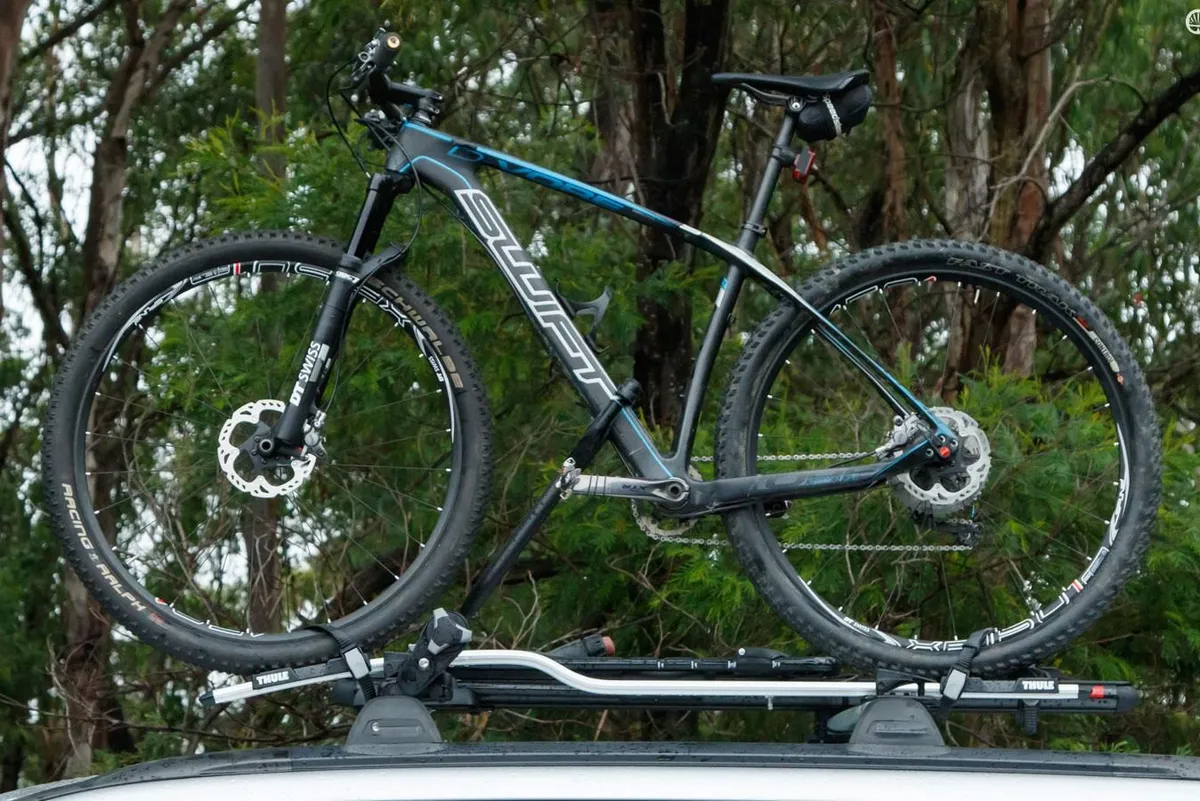
- £117.50 / $199.95 / AU$299 as tested
- Pros: Secure hold; delicate on carbon wheels; great compatibility; easy to use
- Cons: Pricey
The Thule ProRide 598 is a benchmark for roof racks and a great all-round choice as long as you're happy to clamp directly onto the down tube of your bike (the jaws are designed in such a way as to minimise the risk of damage).
The 598 is ideal if you want to transport bikes with mudguards because, unlike those that hold the bike by its wheels only, the rack won't interfere with them.
- Read more: Thule ProRide 598 review
SQUIRREL_13086809
Yakima Highroad
SQUIRREL_TEXT_13165263
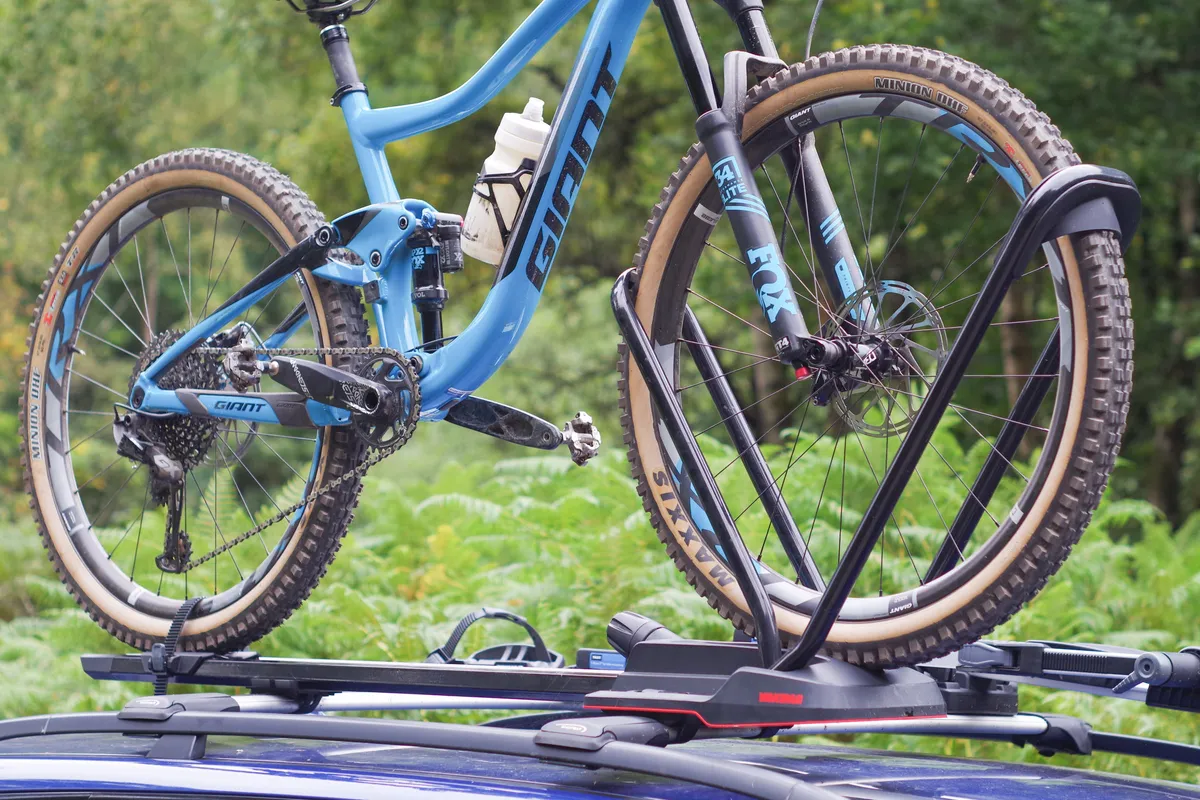
- £175 / $249 / AU$349 as tested
- Pros: Holds one bike by its wheels only, no contact with frame; accepts wheels from 26in to 29in
- Cons: Not compatible with full front mudguards
The Yakima Highroad mounts on virtually any roof bars and is an ideal choice if you're worried about scratching your frame, because it holds your bike by its wheels only.
Mounting a bike on the Highroad is particularly easy, with no need to adjust the front wheel hoops for different-sized rims and tyres. A built-in cable lock adds a bit of security, although you'll need to pay extra for the lock barrel.
It's a sleek design that's fairly unobtrusive when folded flat. The only major downside is that racks like this are completely incompatible with full-length front mudguards.
SQUIRREL_13165263
Best boot or trunk racks for bikes
Saris Bones EX
SQUIRREL_TEXT_13205939

- £224.99 as tested
- Pros: Easy to install; lightweight; simple design
- Cons: Can't open boot with rack on; lock is an added cost
The Bone EX has a simple design, with four plastic arms and a variety of straps securing your bike to the rear of your car.
We found the rack secure when driving, and its light weight makes it easy to install and handle when not in use.
There are some drawbacks to the rack, with the boot not accessible when installed and the lock not provided.
SQUIRREL_13205939
Thule OutWay Hanging 3
SQUIRREL_TEXT_13120098
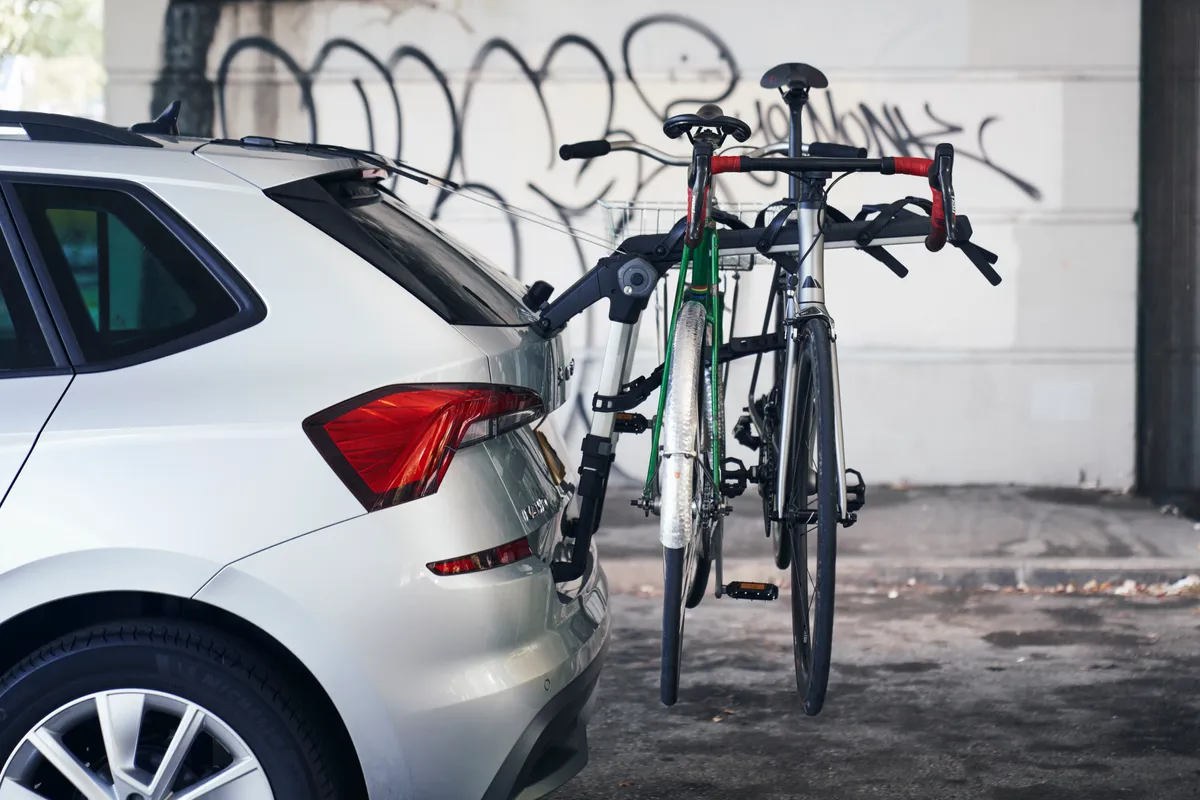
- £400 / $475 / €490 as tested
- Pros: Can be locked to the car boot/trunk for security; arms can be folded when the rack is not in use
- Cons: Bike is only secured with cable
The OutWay sits halfway up Thule's bike rack range and can be locked to the car boot/trunk, with bikes locked to the rack, adding extra security over Thule's cheaper racks. However, the bikes are secured with only a cable, which would be easy to cut.
With practice, mounting and dismounting the rack and bikes isn't too long and you can fold the rack arms down when it's not in use. Load capacity is up to three bikes of up to 15kg, for a total of 45kg weight, while the rack itself weighs just under 9kg.
- Read more: Thule OutWay Hanging 3 review
SQUIRREL_13120098
Best towbar or hitch racks for bikes
Thule Epos 2-bike
SQUIRREL_TEXT_13120108
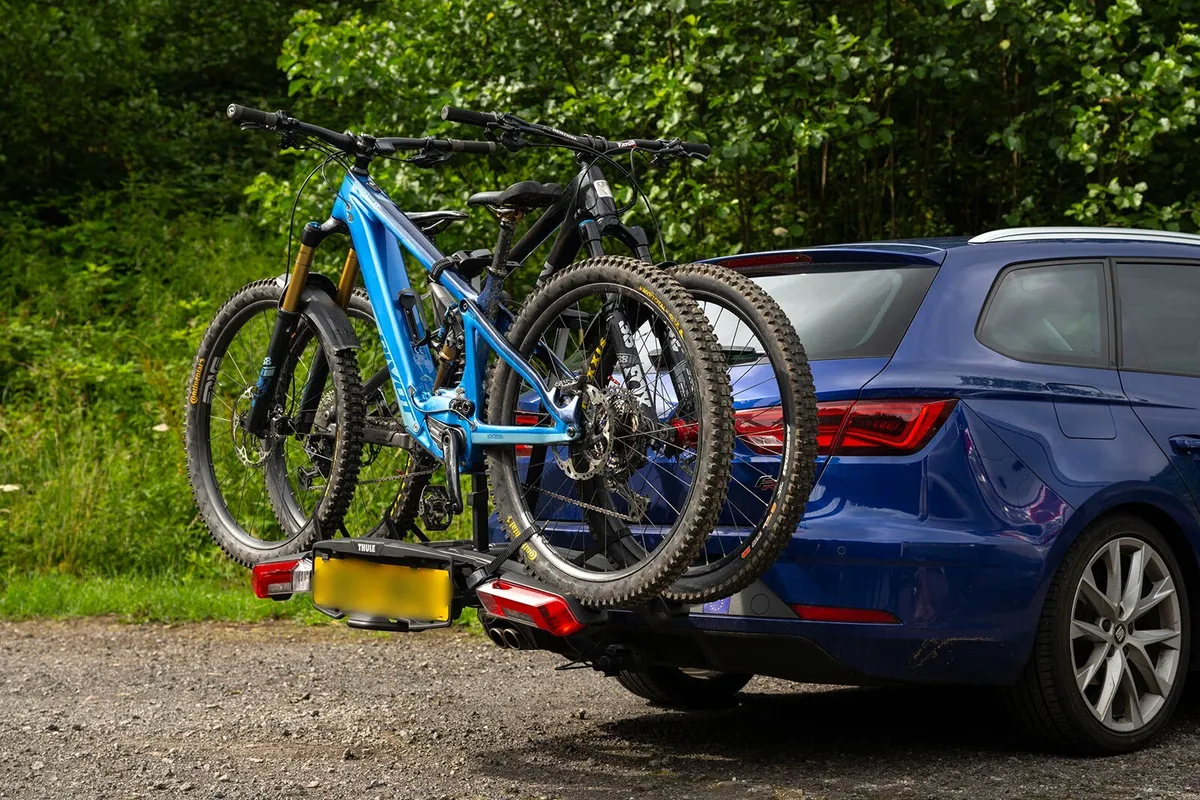
- £1,000 / $1,000 / €1,100 / AU$1,999 as tested
- Pros: Easy to use; clever telescopic arms; secure feeling; great compatibility
- Cons: Pricey
The Thule Epos 2-bike platform towbar bike rack holds two bikes, is easy to use and intelligently designed.
It can fit two bikes weighing up to 30kg each. Bikes are held in place with telescopic arms, helping the carrier pack down small when not in use.
The rack attaches to a towbar with a handbrake-style design and our tester found it to be stable at motorway speeds, even when loaded with ebikes.
The only drawback is the price, but if you’re using a bike rack regularly, it will prove a worthwhile investment.
- Read more: Thule Epos 2-bike review
SQUIRREL_13120108
Thule VeloSpace XT 3 towbar bike rack
SQUIRREL_TEXT_13086808
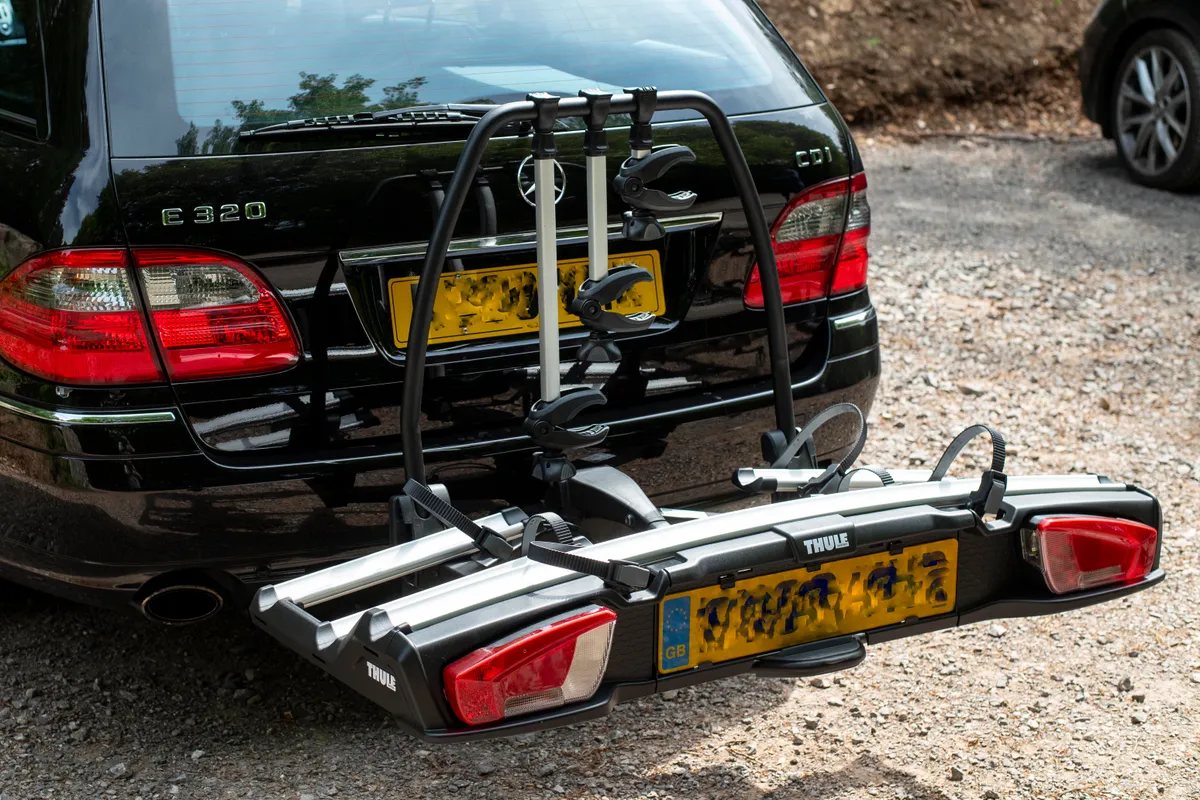
- £700 / €799.95 / AU$1,499 as tested
- Pros: Secure contact with bikes; easy to attach bikes; can carry heavy bikes
- Cons: Heavy weight makes installation harder; large size makes it hard to store; pricey
The VeloSpace XT 3 bike rack is an impressively capable rack that can carry up to 60kg of bike spread over three loading locations.
It’s well made and exceptionally easy to use, and is very sturdy even on the bumpiest of roads – the bikes barely move and are secured very well.
The only pitfalls are its size, which means storage can be an issue, and its rather cumbersome weight that can make it hard to lift around. It also has unproven locking features that should be treated as a last resort. These niggles mean it loses out on a full five-star rating.
Don’t let that put you off, though, the stability offered for your bikes is second to none.
SQUIRREL_13086808
How we test bike racks for cars
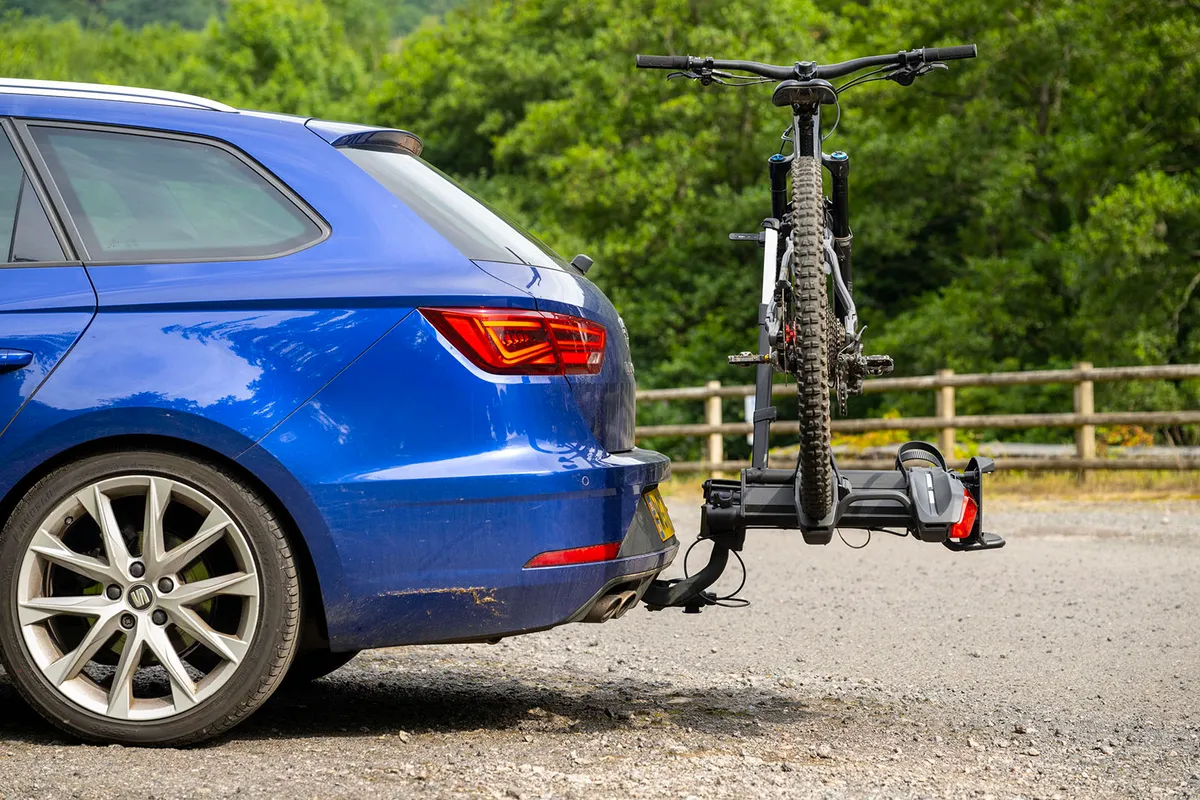
We test bike racks by carrying bikes to trailheads and car parks across the country to enjoy our rides.
Our testers have a lot of experience with bike racks and have a good understanding of what makes a good or great one.
We test a variety of bikes, including electric bikes, on the racks to see how they hold up to different disciplines and weights.
Ultimately, our bike rack reviews are based on the following criteria:
- Security – how secure is the bike rack, and is a lock provided?
- Ease of use – are bikes easy to mount and is the rack easy to install?
- Build quality – is the rack built well?
- Value for money – how does the rack compare to the competition? Are you getting a good deal?
Why you can trust BikeRadar
BikeRadar has been an authority on bikes and cycling tech since its inception in 2007, delivering the world’s best riding advice.
We have experts testing all types of bikes, parts, clothing and accessories, from road, mountain and gravel bikes to commuting, bikepacking and electric bikes.
Our reviews are always editorially independent – with no exceptions. Our reviewers comprehensively test all products in the real world, always reflecting on performance, value and the wider market when delivering their verdicts and review ratings.
We have more than 15,000 product reviews available at your fingertips, as well as expert buying, maintenance, training, skills, health and fitness advice.
Our annual Bike of the Year test is an industry benchmark and the BikeRadar team consists of some of the most experienced riders and testers in the business.
Bike racks for cars buyer's guide
What type of bike rack do I need?
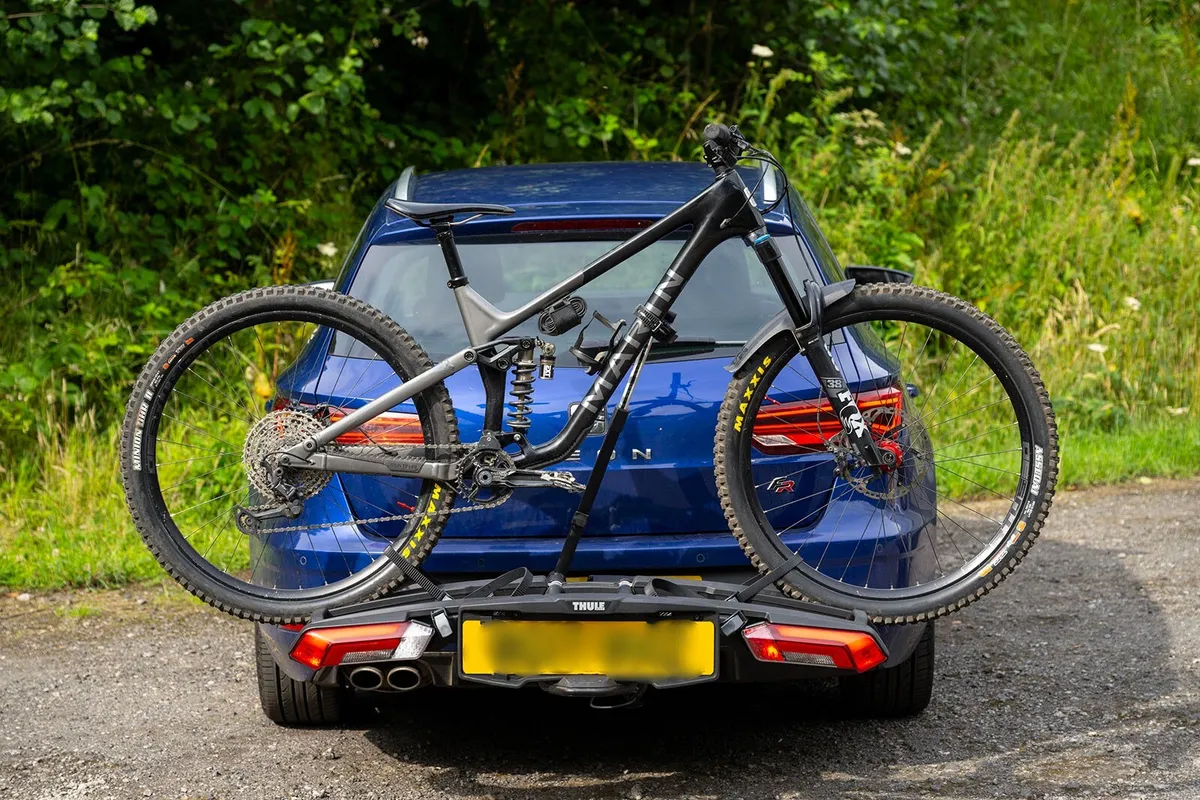
When considering what type of bike you need, the first question you should ask is: how far and how frequently do you need to carry bikes?
Then what type of bikes and how many bikes you need to carry. Which vehicle – or vehicles – do you have, and will you be taking a mixture of bikes? Are they heavy, do they have thru-axles, and will they be getting dirty?
The next question is how do you want to carry the bikes? On top of the vehicle? Off the back? Does your vehicle have a receiver hitch? Bike's front wheel on or off? Another thing to consider is if you want or need to carry other sporting equipment.
Bikes vary widely in cost, style, size and weight too, all of which should be factors when looking for a means of transporting them. You probably won’t want to risk carrying your road bike on a rack that costs less than one of its ultra-light tyres.
You should also consider practicality: whether the rack will suit your needs now and in the future; ease of use – how easy it is to fit to the vehicle and load; security – whether it holds the bikes safely and locks the bikes to the rack and the vehicle; and how much storage space it will take up when not in use.
If you're heading off on a cycling holiday, check out our article on how to pack your road bike for a trip abroad.
What types of bike racks are there?
Below, we explain the major types of car racks for carrying bikes and their pros and cons.
Roof-mounted bike racks
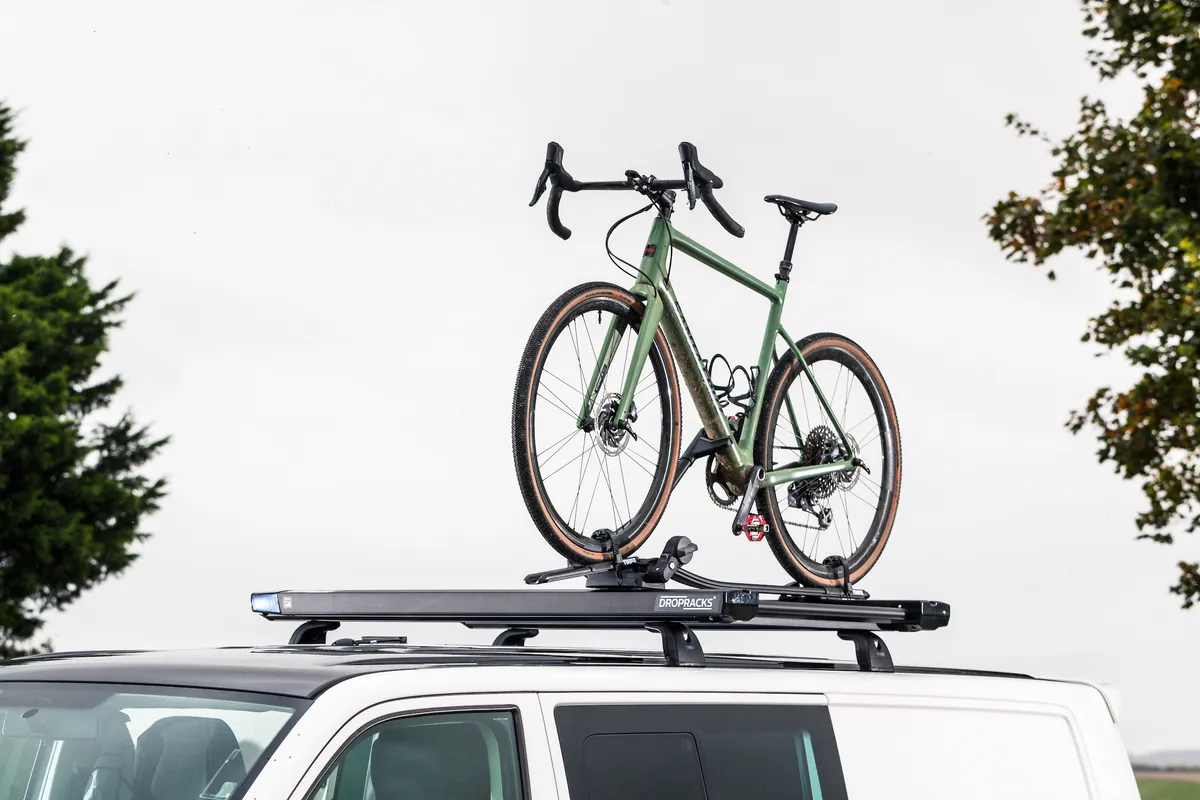
- Pros: Super-versatile for all kinds of gear hauling; one of the most secure rack types available; doesn't hinder access to any doors/boot/hatch/tailgate
- Cons: Drive under something low if you've forgotten about your bikes and you could wreck them and damage your vehicle; you're also adding aero drag to your vehicle, so fuel consumption will likely increase
Most roof racks consist of feet that attach to your vehicle's roof, and cross bars to which the accessories attach. Bike racks for roof racks vary between ones that require front-wheel removal and racks that allow both wheels to remain on the bike.
Front-wheel removal keeps the bike lower (great for tall SUVs), can be easier and lighter to load, and is the classic way of hauling bikes up-top.
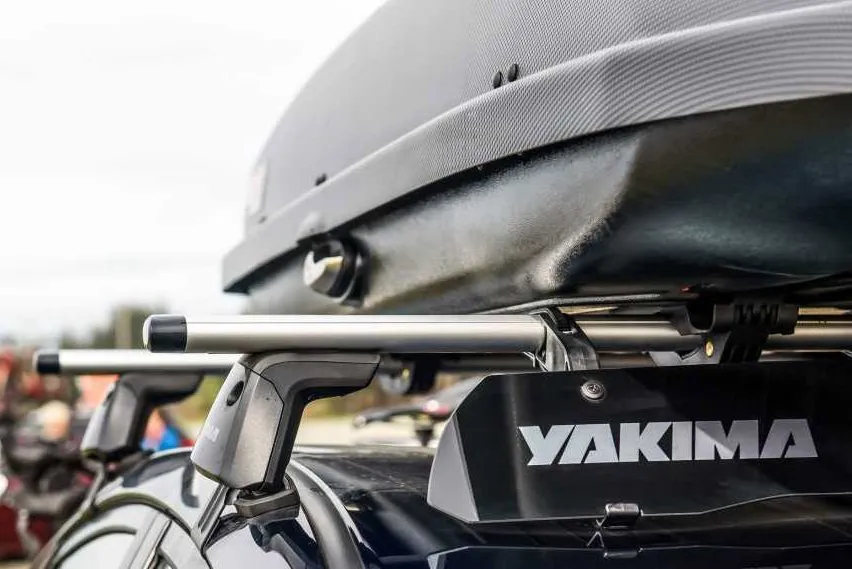
Bike racks that keep both wheels on the bike are taller, generally cost more, and can be less stable. However, they avoid frequent wheel removal and re-installation.
Either option often includes integrated locks to secure your bike to the rack. And, of course, the rack is locked to the bars, and the bars are locked to your vehicle.
There are simpler roof-mounted bike racks available that don't require a dedicated base bar setup, such as the SeaSucker rack (below), which uses suction cups to attach to your car. There are also roof-mounted bike racks that attach to your vehicle's factory-installed roof rack.
While not permanent, roof racks generally stay on your vehicle all the time because they are hugely versatile – being able to add and remove sport-specific accessories enables you to carry bikes, kayaks, skis, SUP boards, cargo boxes, etc.
Basically, any big, bulky item is fair game for a roof rack, even ladders, lumber and other non-sport items.
Boot, hatch or trunk-mounted bike racks
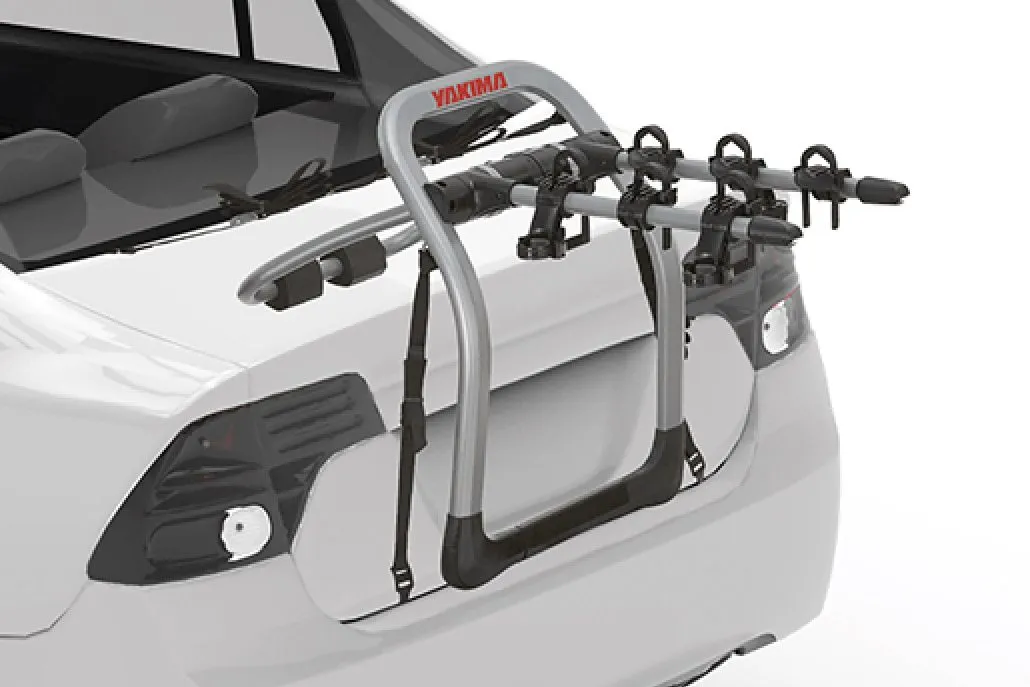
- Pros: Easy to fit and usually the least expensive option; easy to remove, small and foldable for easy storage
- Cons: Least secure way to haul bikes; prone to damaging paintwork; if you don't fit it right you can lose the lot when driving; bikes are easy to steal
Trunk-mounted racks tend to be the least expensive option, and the least secure. The main thing holding them to your vehicle is a bunch of straps that hook around the lip of your vehicle's trunk/hatchback/bumper.
Such racks are usually highly adjustable, so you can fit them to the rear of almost any vehicle. Rubber or foam 'feet' grip the vehicle, with the whole unit pulled taught and secured by the straps.
This is the most affordable style of rack, but relies heavily on it being fitted properly, and the hooks that hold the straps to the vehicle can sometimes damage paintwork.
Low-end trunk racks typically don't have a way to lock your bike or a way to be locked to your vehicle, so they're also relatively easy to steal.
Hitch bike racks and towbar bike racks

- Pros: Good ones are strong, and because they're behind the vehicle and out of the way of the main airflow, fuel consumption doesn't suffer too much; loading and unloading bikes is super-simple; security can be very good
- Cons: You need a towbar or hitch; with the bikes off, reversing can yield some rather horrifying results if you forget about the rack; may necessitate an accessory number plate in some territories
Towbar or hitch-mounted bike racks connect to a 1 1/4in or 2in receiver hitch that is mounted to your vehicle. They're usually more expensive than other bike rack styles, but the ease of loading and unloading bikes, and not having to lift them onto the vehicle's roof makes them a popular option.
Most feature locks that secure the bike to the rack and the rack to the vehicle. Clever designs enable almost one-handed fitting, while hinged load sections provide access to the boot/tailgate of the vehicle without having to remove the bikes.
As a basic rule, the more features a rack has, such as built-in locks, repair stands, lightweight materials, etc, the more it costs. You also need a towbar/hitch on your vehicle, which can be an extra expense if you don't already have one, and some vehicles are only compatible with 1 1/4in hitches, which typically limit the rack to two bikes instead of four or five bikes, as with a 2in hitch.
Hitch-mounted racks most commonly hold bikes by their wheels, with an arm securing the front wheel or by hanging from their top tubes.
A note for our Australian readers: if your hitch-mount rack obscures the view of your number plate, you'll also need an illuminated accessory number plate. While the name varies from state to state, you'll need an official road authorities plate and can be fined for a cardboard, photocopied or handwritten version.
The cost of bike rack number plates varies depending on where you live but they cost less than AU$50 and can be purchased from your local RTA office.
If you plan to drive in poor light conditions or at night, the bike rack plates will also need to be illuminated so they are visible from a distance of 20 metres, accessory light boards are available for most hitch-mount racks. Finally, you may also be fined for driving around with an empty hitch rack on your car.
Speciality racks
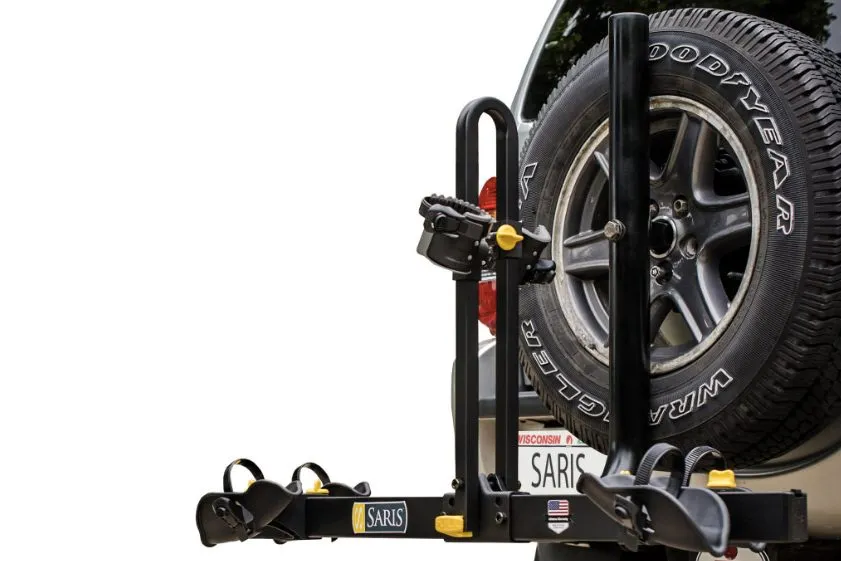
Companies make bike racks for virtually every type of vehicle: from pickup truck beds to SUVs with a spare tyre on the back door, there's a way to safely and conveniently carry your bike.
One solution you've probably seen on trucks at the local trailhead/trail centre is the tailgate pad.
Fancy versions have hook and loop tie-downs to keep bikes separated and secure, while homemade versions, such as old blankets or a couple of bike boxes folded over, are a bit less sophisticated.
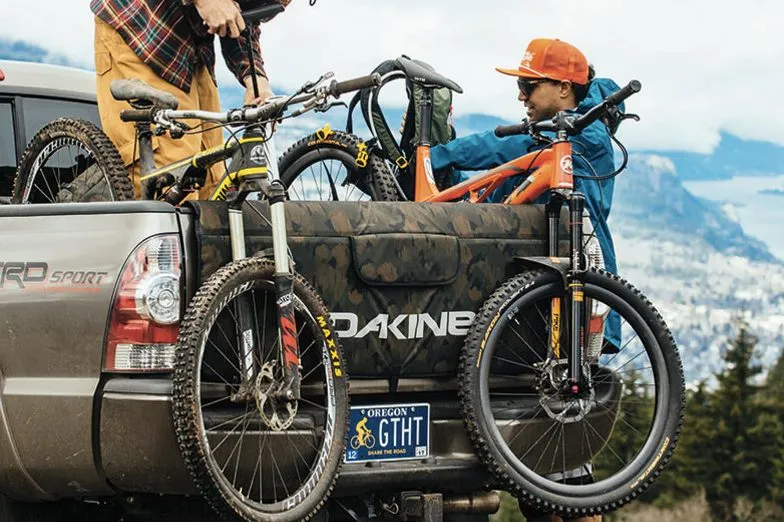
Just like the bike you ride, lots of thought and engineering has gone into the racks designed to carry your bikes on your vehicle. So figure out what your needs are and what style best suits your lifestyle, and transport your bikes easier and faster than ever.
